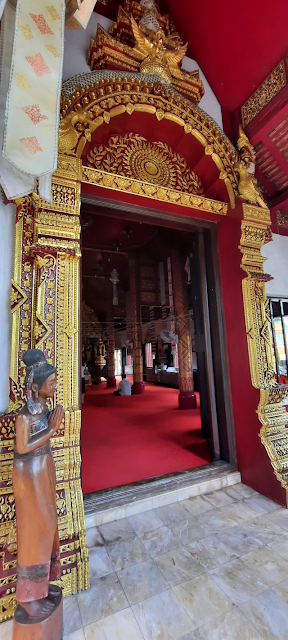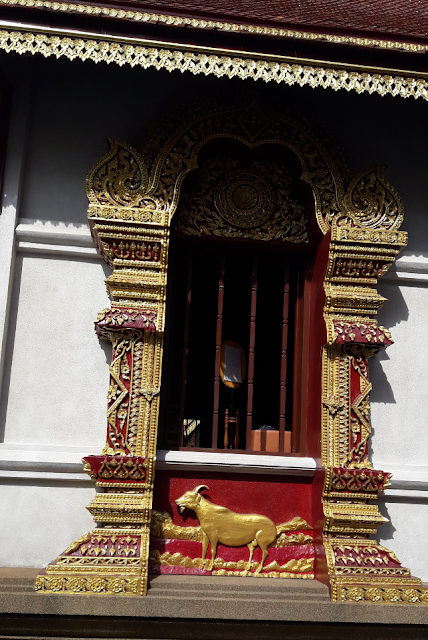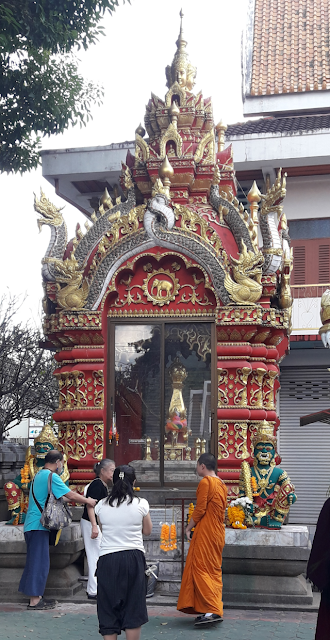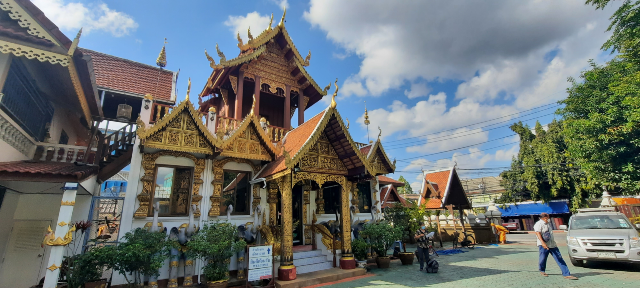The Wat Klang Wiang is one of the most beautiful temples in Chiang Rai. You are awestriken the moment you get inside the complex. Wat Phra Singh, Wat Phra Kaew, Wat Ming Muang, I can go on and on but in Wat Klang Wiang, every structure is exquisite and richly decorated.
History:
- Though renovated after a violent storm badly damaged it in 1903, the temple dates to at least 15th century. According to the information at the temple, it was built 560 years ago (calculated in 1992). So probably, the temple was built around 1432.
- It was known as Wat Chan Ta Lok earlier after a big red sandalwood tree (Chan Deang) which is considered sacred used to grow in the temple premises. With age, the tree came down after some time.
- When Chiang Rai was established, survey of city showed that Wat Klang Wiang was situated exactly in the center. This gave it the name Chan Lok Klang Wiang, Klang (center), Wiang (walled city). This soon came to be known as just Klang Wiang.
- A 1.5 meter city pillar made of brick and clay was erected at the place of red sandalwood tree which was not very strong so also came down.
- Phra Kru Sasana Kit Kosul, the temple's abbot and some disciples decided to erect a city pillar to replace the old one. A chedi was built at the place of the tree on the occassion of Her Majesty Queen Sirikrit's 60th birthday on 12th August 1992.
The main structures here, are the ubosot, the viharn, a scripture library, the chedi and the city pillar shrine.
Close to the Ho trai or the library to city pillar are kuti or monks living quarters
What to see here:
- Every structure in the temple complex is worth spending time on.
- Lanna style viharn with naga tails circling the temple pillar and golden lions at entrance.
- main image in viharn
- Buddha in different mudras on top of windows inside the viharn
- city pillar inside glass, with guardians in green
- look upwards to see Thao Jatulokbal with four faces in four directions
- ubosoth and carved wooden pillar
- white chedi with elephants
- scripture hall with elephants coming out of room
- wells in complex
Viharn:
A very ornatel Lanna style (Northern Thailand architecture) viharn stands right in front of entrance.
Entrance to viharn is guarded by naga and golden singha or lions.
Naga and golden lion, at the back, a standing figure in wai position
Devta on the side in wai posture, the prayer-like greeting performed with palms pressed together
the tails of naga coil around the red and golden columns
naga at entrance
two standing figures on either side at entrance, also can be seen Chinese zodiac figures at sides
gold and red decorated pediment at viharn entrance
entrance door
Inside, a huge golden Buddha sits on a pedestal surrounded by many small images.
I was fascinated by the grid formed of white thread in the hall.
If, you have been to a wat, a red thread is tied to your hands. This is sai sin which is blessed in advance by a monk and is supposed to provide protection and good health.
This can also be seen in a wat, but here the color of thread is not red but white which signifies purity. The string was attached to main Buddha figure. This is also sai sin, which blesses those who visit the wat.
Thank you very much Ms. Chananthorn Thiusathien (Ploy) for the clarification.
main image, on the sides beautifully decorated red and golden pillars
decorated ceiling
Buddha image above window
Buddha in various postures
a painting of wat, must be soon after it was renovated
The three tiered roof of viharan is decorated with golden finials and end in naga at corners. Each window has Chinese zodiac animals below it.ridges on top of window of viharn, goat(Chinese zodiac animal) below
City Pillar:
As soon as entering the temple complex, a beautiful red and golden structure which you cannot miss on left side is the shrine of city pillar. The city pillar can be seen behind the glass.
devotees paying homage
this structure houses the city pillar
On the top is an image of Thao Jatulokbal, god of direction. According to Lanna beliefs, he looks on all four directions and provides protection to everyone.
The red and gold very ornate shrine has many naga and dragons on corners, tails wound around each other.
city pillar inside the shrine
The city pillar here, looks very similar to the one at Wat That Doi Cham.
Yakshas or guardian figures on either side guard the city pillarUbosoth or Ordination Hall:
Just behind the viharn and next to chedi, is the striking rather small ubosoth or ordination hall for the monks.
The bargeboards end in naga and is decorated with flower motifs.
The beautifully decorated red and golden reminds me more of South Indian temple than the Thai Lanna architecture.
There are few wats, which do not permit women inside the ubosoth. I had been to Wat Suphan in Chiang Mai, no women are permitted inside the ubosoth. I had to send my husband inside to click few pictures :)Two exquisite carved wooden pillars stand on either side of entrance
Stupa or Chedi:
The white stupa was built in 1992 in exactly the same place where the red sandalwood tree once stood fell down.
The chedi stands on a black square platform with umbrellas on its four corners.
On top of the black platform, stands the hexagon chedi which has grey colored elephants with golden jewelry. They give an impression of coming out of chedi. This reflects Sri Lankan influence in the architecture of this wat.The chedi has three tiers, upper one getting smaller than the one below with niches where Buddha images are enshrined.The chedi is topped with spire and a hti or umbrella.Temple gongs
Close to chedi, is the temple gong and bells to notify monks of schedules.
Another ornamented building just opposite to chedi, is ho trai or library. The library stores Buddhist scriptures and is supposed to be a very important part of a Buddhist monastery.
ho trai
entrance to library flanked by four elephants on either side
Four half body elephants give an impression of their emerging from inside!
The library has a triangular roof and a small balcony. The scripture hall houses Buddhist scriptures.
black and gold decorated pillars at entrance
entrance to library guarded by moms, mythological animal
The elephants coming out of the building probably reflect the Sri Lankan influence on this wat.
gilded doors of library
inside ho trai
murals on wall
sign outside monks kuti or living quarters
Other structures in the temple:
Apart from these structures, there are few more things in the complex. Very close to viharn is the bell hall, cart hall.Bell gong hall
Cart hall
temple plan
There are two wells in the temple. Earlier, when city water supply was not there, people used to draw water from these two wells to use for their daily use.
well number 2, not in much use
well number one, in use even today
well number one
Ho trai and well number one
image of Buddha near garden number 3
Timings: open daily. 8: 00 am to 8:00 pm
Entrance: free
Getting to the wat is very simple, from the new clock tower, proceed to Uttarakit, you reach old clock tower, turn right, keep walking on Uttarakit and within 3 minutes, you should the temple on your right. It is the side entrance.























































No comments:
Post a Comment
Thanks for visiting my blog. Your feedback is always appreciated.